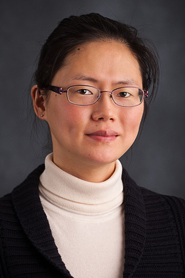Fu Laboratory
Xiaoyun Fu, Ph.D.
Research in the Fu lab focuses on disorders related to inflammation and thrombotic diseases, conditions that can be enhanced by our own immune systems. White blood cells respond to local sites of infection by releasing a host of factors capable of destroying invading pathogens and bacteria. One of the immune responses is to generate bacteria-killing oxidants which work just like bleach to “disinfect.” However, these powerful oxidants can also damage the surrounding healthy tissue, causing organ and/or blood vessel injury.
Our research uses mass spectrometry and biochemical methods to better understand the pathophysiology (abnormal functional changes) of a wide range of diseases related to inflammation and thrombosis and develop methods for prevention and new therapeutic strategies.
Areas of Study
- The oxidation, cleavage, and mutations of blood clotting proteins
- Storage lesion of blood components using metabolomics based approaches
- Clinical trials to evaluate antioxidant therapy and identify biomarkers for oxidative stress
Notable Discoveries
- NAC treatment corresponds with a decrease in protein bound cysteine in SCD and TTP patients undergoing clinical trials.
- Poly-unsaturated fatty acids and their oxidation products accumulate in both leukoreduced and non-leukoreduced red blood cell and platelet units.
- Developed an assay that incorporates mass-spectrometry and immunoprecipitation to quantitatively measure mutations, oxidation, and cleavage of VWF in the plasma of patients with clotting and bleeding disorders.
Dr Fu’s Background
- Joined Bloodworks Northwest as an associate member in 2008.
- Ph.D. in Chemistry from Zhejiang University (China)
- Served as Professor of Chemistry at Zhejiang University
- Joined the faculty at the University of Washington School of Medicine in 2002
Areas of Study
Research in our laboratory focuses on the role of protein oxidation and other post-translational modifications in the pathogenesis of inflammatory and thrombotic diseases by incorporating the use of mass spectrometry and analytical biochemistry. These studies encompass three primary areas:
Blood Coagulation Proteins
A major effort in our laboratory centers on the molecular mechanisms regulating blood coagulation proteins. We are currently investigating von Willebrand factor (VWF), ADAMTS13, and fibrinogen under oxidative conditions. We propose that oxidants produced by activation of inflammatory cells might modify the ability of ADAMTS13 to effectively cleave VWF. Furthermore, we are investigating the effects of fibrinogen oxidation and degradation products on its polymerization, which may play a key role in blood clotting events. These studies are in collaboration with Dr. José López at the Bloodworks Northwest Research Institute, as well as Investigators at the University of Washington. The long-term goal is to explore the functional consequences of post-translational modifications (PTMs) in blood coagulation proteins and to discover biomarkers for related diseases.
Red Blood Cell (RBC) Oxidation and Storage Lesion
It has been reported that the RBC storage lesion is associated with oxidation of the cell during storage, but very little is known about the molecular mechanisms. We are currently applying proteomic approaches to study the role of post-translational modifications to both membrane proteins and hemoglobin in the RBC storage lesion and RBCs from patients. Our long-term goal is to understand the role of specific modifications, including oxidation, phosphorylation and glycosylation, on the viability of stored and diseased red blood cells.
Oxidative Stress Markers for Clinical Trials
Oxidative stress has increasingly been associated with the pathogenesis of a wide variety of diseases including sickle cell disease (SCD) and thrombotic thrombocytopenic purpura (TTP). In collaboration with Drs. Konkle and López, we are evaluating the use of N-acetylcysteine (NAC) as an antioxidant treatment in patients suffering from SCD or TTP, and are focused on determining relevant biomarkers for measuring oxidative stress. Glutathione (GSH) has long been identified as a biomarker of oxidative stress, but it is especially difficult to quantify in plasma and there are numerous related metabolites which may also be important in evaluating oxidative stress. We have developed a liquid chromatography-mass spectrometry (LC-MS) method to quantify a panel of small-molecule thiols and disulfides, including NAC, in a variety of sample types, representing the most complete LC-MS method to date. Our method can further be used to quantify the distribution of these thiols between free and disulfide form, including those bound to protein.
Representative Publications
- Fu X, Kassim SY, Parks WC, Heinecke JW: Hypochlorous acid oxigenates the cysteine switch domain of pro-matrilysin (MMP-7): A mechanism for matrix metalloproteinase activation and atherosclerotic plaque rupture by myeloperoxidase. J Biol Chem 276(44):41279-41287, 2001. PMID11533038
- Fu X, Mueller DM, Heinecke JW: Generation of intramolecular and intermolecular sulfenamides, sulfinamide, and sulfinamide by hypochlorous acid: A potential pathway for oxidative cross-linking of low-density lipoprotein by myeloperoxidase. Biochemistry 41(4):1293-1301, 2002. PMID11802729
- Fu X, Kassim SY, Parks WC, Heinecke JW: Hypochlorous acid oxygenated by myeloperoxidase modifies adjacent tryptophan and glycine residues in catalytic domain of matrix metalloproteinase-7 (Matrilysin). J Biol Chem 278:28403-28409, 2003. PMID12759346
- Fu X, Kao J, Bergt C, Kassim SY, Huq NP, d’Avignon A, Parks WC, Mecham RP, Heinecke JW: Oxidative cross-linking of tryptophan to glycine restrains matrix metalloproteinase activity. J Biol Chem 279:6209-6212, 2004. PMID14670964
- Bergt C, Fu X, Huq, NP, Kao J, Heinecke JW: Lysine residues direct the chlorination of tyrosines in YXXK motifs of apolipoprotein A-I when hypochlorous acid oxidizes high density lipoprotein. J Biol Chem 279:7856-7866, 2004. PMID14660678
- Shao B, Belaaouaj A, Verlinde CL, Fu X, Heinecke JW. Methionine sulfoxide and proteolytic cleavage contribute to the inactivation of cathepsin G by hypochlorous acid: An oxidative mechanism for regulation of serine proteinases by myeloperoxidase. J. Biol Chem. 280(32) 29311-21, 2005.PMID15967795
- Kassim SY, Fu X, Liles WC, Shapiro SD, Parks WC, Heinecke JW: NADPH Oxidase Restrains the Matrix Metalloproteinase Activity of Macrophages. J. Biol. Chem. 280(34): 30201-5, 2005. PMID15983040
- Shao B, Fu X, Mecdonald TO, Green PS, Uchida K, O’Brien KD, Oram JF, Heinecke JW: Acrolein Impairs ABCA1-dependent Cholesterol Export from Cells through Site-Specific Modification of Apolipoprotein A-I. J. Biol. Chem. 280(43):36386-96, 2005. PMID16126721
- Fu X, Wang Y, Kao J, Irwin A,d’Avignon A, Mecham RP, Parks WC, Heinecke JW: Specific Sequence Motifs Direct the Oxygenation and Chlorination of Tryptophan by Myeloperoxidase. Biochemistry 459(12), 3961-71, 2006. PMID16548523
- Wang Y, Rosen H, Madtes DK, Shao B, Martin TR, Heinecke JW, Fu X: Myeloperoxidase inactivates TIMP-1 by oxidizing its N-terminal cysteine residue: An oxidative mechanism for regulating proteolysis during inflammation. J. Biol. Chem. 282(44):31826-34, 2007. PMID17726014
- Fu X, Gharib SA, Green PS, Aitken ML, Frazer DA, Park DR, Vaisar T, Heinecke JW: Spectral Index for Assessment of Differential Protein Expression in Shotgun Proteomics. J. Proteome Res. 7(3) 845-854, 2008. PMID18198819
- Gharib SA, Green PS, Aitken ML, Frazer DA, Park DR, Vaisar T, Heinecke JW, Fu X: Mapping the lung proteome in Cystic Fibrosis. J. Proteome Res. 8(6):3020-8, 2009. PMID19354268
- Yuan W, Wang Y, Heinecke JW, Fu X: Hypochlorous acid converts the γ-glutamyl group of glutathione disulfide to 5-hydroxy-butyrolactam: a potential marker for neutrophil activation. J. Biol. Chem. 284(39):26908-17, 2009. PMID19584048
- Rosen H, Klebanoff SJ, Wang Y, Brot N, Heinecke JW, Fu X: Methionine Oxidation Contributes to Bacterial Killing by the Myeloperoxidase System of Neutrophils, Proc. Natl. Acad. Sci. USA, 106(44):18686-91, 2009. PMID19833874
- Chen J, Fu X, Wang Y, Ling M, McMullen B, Kulman J, Chung D, López JA: Oxidative modification of von Willebrand factor by neutrophil oxidants inhibits its cleavage by ADAMTS13. Blood, 115(3) 706-12, 2010. PMID19812385
- Chen J, Reheman A, Gushiken FC, Nolascol L, Fu X, Moake JL, Ni H, López JA: N-acetylcysteine reduces the size and activity of von Willebrand factor in human plasma and mice. J. Clin. Invest, 121(2):593-603, 2011. PMID21266777
- Herrero R, Kajikawa O, Matute-Bello G, Wang Y, Hagimoto N, Mongovin S, Wong V, Park DR, Brot N, Heinecke JW, Rosen H, Goodman RB, Fu X, Martin TR, The biological Activity of FasL in humans and mice is determined by the structure of its stalk region. J Clin. Invest, 121(3):1174-90, 2011.PMID21285513
- Fu X, Chen J, Gallagher R, Zheng Y, Chung DW, López JA: Shear stress-induced unfolding of von Willebrand factor accelerates oxidation of key methionine residues in the A1A2A3 region. Blood. 118(19) 5283-91, 2011. PMID21917758
Fu Laboratory Members
 |
Yi Wang, Ph.D. Research Scientist Email: [email protected] Phone: (206) 568-2243 FAX: (206) 587-6056 |
 |
Mikayla Anderson Research Technologist I Email: [email protected] Phone: (206) 568-3603 FAX: (206) 587-6056 |
 |
Melissa Dominguez Research Technologist II Email: [email protected] Phone: (206) 568-2258 FAX: (206) 587-6056 |
 |
Mallory Pahl Research Technologist I Email: [email protected] Phone: (206) 568-2239 FAX: (206) 587-6056 |

Xiaoyun Fu, Ph.D.
Associate Member
Director of Mass Spectrometry Laboratory
Research Associate
Professor of Medicine
Division of Hematology
University of Washington School of Medicine
Bloodworks Northwest
Research Institute
1551 Eastlake Avenue E, Suite 100
Seattle, WA 98102
Email: [email protected]
UW Mailstop 359190
Phone: (206) 568-2250
FAX: (206) 587-6056
Rachel A. Sessum
Sr. Administrative Coordinator
Email: [email protected]
Phone: (206) 568-2246
FAX: (206) 587-6056

